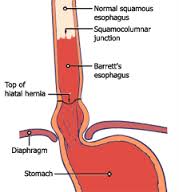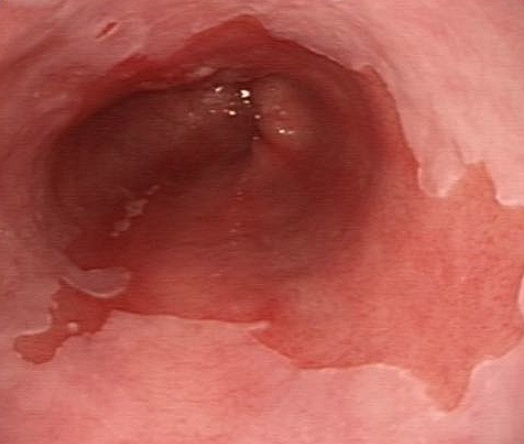Barrett’s Oesophagus
What is Barrett's Oesophagus?
Barrett’s oesophagus is the term used for a condition where the normal cells lining the oesophagus (gullet) have been replaced with abnormal cells. The abnormal cells start from where the oesophagus meets the stomach and spread upwards. The main concern with this condition is that it can increase the risk of developing oesophageal cancer.
How does Barrett's Oesophagus develop?
|
Barrett’s Oesophagus is thought to occur as a result of a number of years of Gastro-oesophageal reflux. Gastro oesophageal reflux disease (GORD) is a disorder in which stomach acid and enzymes spill up into the oesophagus causing injury to the oesophageal lining. GORD can result in symptoms such as heartburn, regurgitation, and chest pain.
In some patients with GORD, the normal oesophagus cells are damaged. Over time, this damage may result in the tissue taking on a different appearance such that it is no longer oesophageal tissue, but rather becomes intestinal tissue. This is called “intestinal metaplasia” or Barrett's Oesophagus.
|
 |
How is Barrett's Oesophagus diagnosed?
| A diagnosis of Barrett's Oesophagus can only be made with an upper gastrointestinal endoscopy (also known as a Gastroscopy). This is where the Endoscopist, inserts a small tube with a camera on the end via the mouth into the oesophagus and stomach. Gastroscopy is a non-surgical procedure and can be performed using a sedative. Barrett's Oesophagus tissue appears as a different colour on endoscopic examination, which directs a biopsy of the tissue for evaluation under a microscope. A finding of intestinal cells in the oesophagus (intestinal metaplasia) confirms a diagnosis of Barrett's Oesophagus. |
 |
What are the risks to the patient who has Barrett’s Oesophagus?
It is important to diagnose and monitor Barrett’s oesophagus because there is an increased risk for a patient with this condition to develop oesophageal adenocarcinoma (a specific type of cancer).
The degree of risk is related to pre-malignant changes, or dysplasia, in the Barrett’s lining. These changes are believed to progress from Low Grade Dysplasia (LGD) through High Grade Dysplasia (HGD) to invasive cancer.
If the biopsy shows Barrett’s oesophagus with no dysplasia, then the risk of developing cancer is around 0.5% per year, however when High Grade Dysplasia is found on biopsy, the cancer risk may be up to 5% per year.
How is Barrett's Oesophagus managed and treated?
The process of cell changes can sometimes be reversed if the acid reflux is well controlled. If a diagnosis of Barrett’s Oesophagus is made, regular acid-suppression medication (such as Omeprazole) is therefore recommended.
International Medical Societies also recommend that a patient with Barrett's Oesophagus should undergo a Gastroscopy procedure with biopsies on a regular basis (this is called surveillance). The frequency of Gastroscopy surveillance is determined by the grade of Barrett's Oesophagus. A patient with intestinal metaplasia without dysplasia will undergo surveillance Gastroscopy approximately every 3-5 years. The frequency for a patient with Low Grade Dysplasia is much higher (every 6-12 months) due to the increased risk for cancer development. A patient with intestinal metaplasia with High Grade Dysplasia may undergo surveillance Gastroscopy every 3 months, or be referred for more definitive therapy immediately.
In conjunction with endoscopic surveillance, changes in lifestyle and medications can assist in halting the progress of the cellular changes. These changes can include weight loss, reduction of alcohol intake, smoking cessation, reducing portion sizes, avoiding eating within 3 hours of going to bed, avoiding medications that make reflux worse, and the regular use of medications that reduce the acid in the stomach.
In addition to surveillance Gastroscopy approaches for Barrett's Oesophagus, there are treatment options that include endoscopic and surgical therapy to eliminate the Barrett’s tissue completely. Patients should consult with their physician to determine what the optimal approach is for their particular disease state.
At Waitemata Endoscopy we are able to offer an Endoscopic therapy that can eliminate Barrett’s Oesophagus called Radio Frequency Ablation. It should be discussed with your specialist to determine what the appropriate treatment option is for you.
Further information on Barrett’s oesophagus and treatment options can be found on the following website;
https://gutscharity.org.uk/advice-and-information/conditions/barretts-oesophagus/





